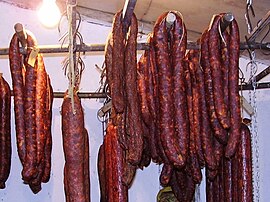| This article needs additional citations for verification. Please help improve this article by adding citations to reliable sources. Unsourced material may be challenged and removed. Find sources: "Hungarian sausages" – news · newspapers · books · scholar · JSTOR (June 2021) (Learn how and when to remove this message) |

Hungarian sausages are sausages found in the cuisine of Hungary. Hungary produces a vast number of sui sausage types. They may be boiled, fresh or dried, and smoked, with different spices and flavors, "hot" or "mild". Many were influenced by their neighbors and brethren.
These sausages may be eaten like a cold cut or used in a main course. Hungarian cuisine uses these different types of sausages in many ways such as in stews, soups, potato stews like "paprikás krumpli" (paprika-based stew with spicy sausage and potatoes), bean soups like Jókai bableves, some goulash soup variations, pastry dishes, or even in salads.
The smoked sausages may contain bacon, ground pork, beef, boar or lamb, paprika, salt, garlic, black pepper, allspice, white pepper, caraway, nutmeg, zest, marjoram, cayenne pepper, sugar, white wine or cognac. Sausages may have additional ingredients like liver, mushroom, bread, rice, lemon juice, eggs, cream or milk.
The meat is coarsely ground and salted. If garlic is added, it is mashed in water to produce a slurry and added to the meat along with spices. The sausage is then stuffed into natural casings in 1-foot links - usually using the small intestine of the pig. This traditionally took place outside on the fall day when a pig was slaughtered. The sausage is then hung overnight to allow the flavors to meld and some of the grease to drip out. It is now ready to be used fresh and unsmoked. The unsmoked sausages are typically roasted with sauerkraut or red or green cabbage, and served with mashed potatoes.
The dry sausages are cold smoked and hung to cure before consumption.
Cooked sausages
Kolbász

Kolbász (Hungarian: [ˈkolbaːs]) is a traditional Hungarian smoked sausage seasoned with paprika. The best known and most popular versions are:
- Gyulai sausage is named after the Hungarian town of Gyula, and has PGI protection. It is slow cooked while being beech wood smoked. It is made from pork, 'szalonna' (Hungarian bacon fat), garlic, pepper, caraway, and a Hungarian red paprika. At the World Exhibition of Food in Brussels 1935, the Gyulai kolbász was awarded a gold diploma. The sausage may be cut into thin slices and eaten alone or with bread. They are also added to many Hungarian dishes including lecsó and potato/egg casserole (rakott krumpli).
- Csabai sausage is made in the town Békéscsaba, and also has Protected Geographical Status (PGI) protection. It is similar to Gyulai, but somewhat spicier. There are several variations in size and type, but it is a spicy sausage with a lot of paprika.
- Csemege kolbász is an mildly spiced cooked smoked sausage
- Cserkész kolbász is a cooked smoked sausage made from beef and pork.
- Debreceni kolbász is usually unsmoked or more mildly smoked, with a strong paprika flavour and used for cooking.
- Lecsókolbász, a spicy cooked smoked sausage made specifically for serving as part of the dish lecsó, a vegetable stew with peppers and tomatoes.
Hurka
Hurka (Hungarian: [ˈhurkɒ]) are boiled sausages that come in two main types "májas" (liver sausage), and "véres" (blood sausage). The main ingredient is liver and rice, or blood and rice. Spices, pepper and salt are added.
Other cooked sausages
- Virsli (Hungarian: [ˈvirʃli]), a hot dog–like long and thin sausage, consumed boiled with bread and mustard.
- Párizsi (Hungarian: [ˈpaːriʒi], Parizer or Paris sausage), is a much larger, thicker version of virsli. It is very similar to the Bologna.
Uncooked sausages
Szalámi
Hungary's most famous salami is téliszalámi (winter salami).
See also
References
- Gundel, Károly (1992). Gundel's Hungarian cookbook. Budapest: Corvina. ISBN 963-13-3600-X. OCLC 32227400.page 24
- Remete, Farkas László (2016). Magyaros és tájjellegű vagdaltak, ál-kolbászok. Kárpát-medencei magyaros konyha. Farkas L., mek.oszk.hu
- Gyulai kolbász / Gyulai pároskolbász, European Commission
- "Gyulai Kolbász (sausage)". Hungarian Horticulture. Archived from the original on 2008-06-07. Retrieved 2008-09-08.
- Csabai kolbász/Csabai vastagkolbász, European Commission
- Gundel, Karoly (1992). Gundel's Hungarian cookbook. Budapest: Corvina. ISBN 963-13-3600-X. OCLC 32227400.page 100
External links
| Sausage | |||||
|---|---|---|---|---|---|
| Overview |  | ||||
| Fresh sausage | |||||
| Dry sausage |
| ||||
| Smoked sausage | |||||
| Cooked sausage | |||||
| Cooked smoked sausage | |||||
| Precooked sausage | |||||
| Grilled sausage | |||||
| Related articles | |||||